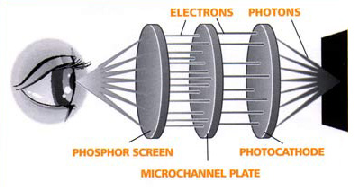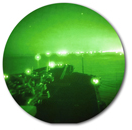

Night Vision technology consists of two major types: image intensification (light amplification) and thermal imaging (infrared). Most consumer night vision products are light amplifying devices. Light amplification technology takes the small amount of light, such as moonlight or starlight, that is in the surrounding area, and converts the light energy (scientists call it photons), into electrical energy (electrons). These electrons pass through a thin disk that's about the size of a quarter and contains over 10 million channels. As the electrons travel through and strike the walls of the channels, thousands more electrons are released. These multiplied electrons then bounce off of a phosphor screen which converts the electrons back into photons and lets you see an impressive nighttime view even when it's really dark.

HOW NIGHT VISION WORKS
GENERAL OVERVIEW:
All image intensified night vision products on the market today have one thing in common: they produce a green output image. Like the one your see above right . But that's where the similarities end.
In the night vision world there are generations that reflect the level of technology used. The higher the generation, the more sophisticated the night vision technology.
Generation 0 -
Generation 1 -

Generation 2 -